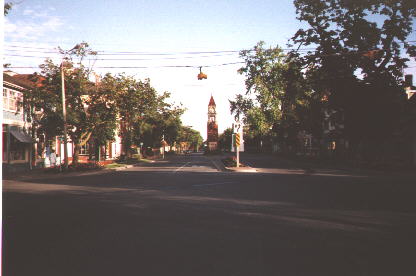


The Americans were quick to act on this withdrawl and reoccupied Queenston and Chippawa. Joseph Willcocks and his Canadian Volunteers also wasted little time making the loyalists left behind pay a heavy price. The farms of those who had once been neighbours and friends were looted and burned. Then Willcocks arrested prominent loyalists and had them sent to prisons in the United States. Among them were Thomas Merritt, William Hamiltons's father and eighty year old Peter McMicking of Stamford County, a coroner and a town warden. William Hamilton Merritt was so angry at the treatment of his father that he wrote in his journal of, "having taken many long and weary ride, in the lonely hours of the night, in hope of catching Willcocks and making an example of him and all traitors."
Colonel John Murray convinced Vincent that a small force should be moved back into the peninsula to protect the inhabitants after hearing of the arrests and raids. Subsequently Murray led a force of three hundred and seventy-eight regulars of the 8th Regiment and some volunteers, including Merritt's Dragoons, to Forty Mile Creek where a base was set up.
Captain William Hamilton Merritt led his troop east away from their base camp atr Forty Mile Creek. Where were the Americans? The Indians had been in contact with their pickets the night before but now they were nowhere to be found.
A signal from an advanced scout brought Merrittt forward quickly and the tail end of the American column was sighted tramping toward Twenty Mile Creek. Merritt sent his dragoons charging down the road scattering the American infantry and fighting a sharp engagement with some American cavalry who quickly withdrew. Some of the infantry tried to fight on, but many quickly surrendered and were taken prisoners of war.
With the American Army in retreat Murray pushed his force forward to Twenty Mile Creek and then to Twelve Mile Creek. By this time the Americans had pulled back to Fort George. The American commanding officer, Birgadier General George McClure was in a tough position. The enlistment of many of his troops was expiring and his force began melting away. Willcock's raid had further alienated the local population and when Murray's outposts soundly defeated a probing force sent out by McClure, he decided to withdaw across the Niagara River to the American side and the confines of Fort Niagara.
The sun came up on 10 December to show a cold and blustery day with snow drifting about two or three feet in places. Joseph Willcocks was beside himself when he heard of the plans to abandon the peninsula. He had at least wrung the order to burn the town from McClure on the pretext of denying shelter to the advancing British troops. Willcocks was determined to punish his former neighbours for slights, real and imaginary, that he had suffered since going over to the Americans. The Canadian Volunteers and American Militiamen went door to door warning inhabitants to get out what they could. At dusk the destruction began.
Willcocks mounted the stairs of the Dickson house, fire brand in hand, followed by two of his men. Willcocks ordered that the two men remove a woman who was ill, bed and all and place her in the snow. He had arrested William Dickson and had him sent off as a prisoner to the United States and was determined to destroy whatever property he could. The two men wrapped her in blankets the best they could and put her in a snow drift while Willcocks burned the house and it's contents. He walked away leaving Mrs. Dickson in the snow to watch her house burn to the ground.
Women and children stood in the cold December winter and watched their homes and almost everything they owned in the world burn into ashes. Their first concern was to find some shelter. there were four hundred refugees who woulds die of exposure if cover could not be found quickly.
Captain Merritt reported to Colonel Murray. The glow in the eastern sky could mean only one thing and with Merritt's dragoons they rode off to investigate.
The troop approached Fort George from the south and carefully reconnoitred the area. The Americans were pulling out and the only troops remaining were the rear guard, which consisted of the Canadian Volunteers. Merritt signaled the charge routing the enemy, killing two and taking a number prisoners.
The scene that greeted them in the town was beyond belief. Every building except one was a pile of glowing embers and the streets were littered with furniture that some had been able to save before their homes were torched. People were desperately seeking shelter. Some moved toward the fort and Butlers Barracks, which had been spared for some reason, others built crude shelters against chimneys using half burnt boards as roofing while still other began bone chilling walks to farms in the neighbourhood.
The next day the sun brought the misery of the town to bloom. many a snowdrift had frozen bodies of women and children who could not find their way in the bitter cold darkness of that December night in 1813.
The mood of the British troops was dark indeed. Every man from Colonel Murray to the lowliest private had one thing on his mind; Vengence!
For his part in the burning of Newark, General McClure was relieved of his command and dismissed from the U.S. Army.
CLICK HERE for more information on Newark (known as Niagara - on - the - Lake today)